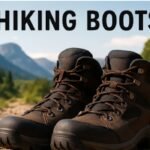Heading out for a hiking trip is an exciting escape into nature, but your choice of footwear can make or break the experience. The marketplace is flooded with different types and styles, making it easy to overlook essential factors while searching for the perfect pair.
From well-maintained tracks to rugged backcountry treks, your hiking conditions demand specific features in your shoes or boots. Understanding these features, knowing your needs, and being aware of what makes hiking footwear durable will help you confidently move through any environment. Quality footwear not only supports your feet but also enhances performance, reducing the risk of injury and fatigue.
Understanding Your Hiking Needs
Your hiking style and the environments you explore play a pivotal role in your footwear selection. For casual hikes on flat, well-maintained paths, lightweight, low-cut shoes may be sufficient. However, if you plan on carrying a heavy pack through rocky or uneven backcountry, sturdy boots with ankle support and hard-wearing construction are ideal. Duration also matters—longer trips require shoes that strike a balance between flexibility, support, and toughness for sustained comfort over hours or even days. Determine whether you require aggressive traction, waterproofing, or additional toe protection based on your typical hiking locations.
Key Features of Durable Hiking Footwear
- Sturdy Construction: Shoes built with double or triple stitching, tough eyelets, and abrasion-resistant overlays will outlast those made with lighter materials. Check for reinforced heels and toes for extra defense against trail hazards.
- Supportive Midsoles: The midsole plays a crucial role in cushioning and absorbing impact. EVA and polyurethane are common materials, with polyurethane generally offering greater durability and support on extended hikes.
- Protective Toe Caps: Toe caps—often made from rubber or thermoplastic—absorb impacts from rocks, roots, and debris, thereby extending the lifespan of your footwear and protecting your feet from injury.
Importance of Proper Fit
Proper fit is essential for hiking boots to prevent pain and blisters. Always try them on with the intended outdoor socks, ensuring your toes can wiggle while checking for heel slippage during inclines to avoid hot spots. Consider that feet may swell during hikes, warranting a slightly roomy toe box. It is advisable to test both boots, taking into account size variations between feet, by fully lacing them to replicate actual trail conditions, and checking all contact areas for pressure or rubbing.
Material Matters
The performance and longevity of hiking footwear are significantly influenced by its material composition. Full-grain leather is characterized by its high durability, natural water resistance, and superior abrasion resistance, making it ideal for challenging terrains. However, it tends to be heavier and requires a more extended break-in period. On the other hand, synthetic materials such as nylon, polyester, or mesh are lighter and dry quickly, making them more suited for warm weather; however, they generally have a lower lifespan compared to premium leather options. Additionally, waterproof membranes like GORE-TEX effectively prevent water ingress while facilitating moisture release, which is crucial for use in wet or snowy conditions.
Traction and Outsole Design
Good traction is your first defense against slips and falls. Look for soles with deep, aggressive lugs for soft, muddy, or uneven surfaces. Durable rubber compounds withstand miles of wear and tear. Some boots feature self-cleaning lugs that eject mud and small stones as you walk, preserving grip across all conditions.
- Tread Patterns: Deep, multidirectional lugs provide superior traction on loose or slick ground.
- High-Quality Rubber: Premium rubber compounds, such as Vibram, are renowned for their ability to combine grip and durability.
- Rock Plates: Some shoes have embedded plates for protection on extremely rocky trails.
Waterproofing and Breathability
Staying dry is about more than comfort—wet feet can mean blisters, chills, and cut trips short. Waterproof hiking boots utilize liners like GORE-TEX or proprietary membranes to keep water out while allowing heat to escape. For hot and dry climates, prioritize mesh panels for airflow, even if it means sacrificing some water resistance. Balance your needs based on local weather and trail conditions.
Breaking In Your Footwear
Even the best hiking boots need some personalization before you trust them on a long trip. Break in footwear by first wearing them for short durations around home, then gradually extending usage. Use the same hiking socks and insoles to mimic actual use. Watch for persistent pressure points—these can be mitigated with lacing techniques or aftermarket insoles. Never start a long hike with brand-new boots to avoid unexpected pain or injury.
Maintenance and Care
Proper maintenance extends the lifespan of your hiking shoes. Clean after hikes with a brush and lukewarm water, then dry at room temperature away from heat. Remove insoles to prevent odor. Store in a dry, airy place away from sunlight to maintain waterproof qualities. Well-maintained footwear ensures safety, comfort, and adventure over many miles.
Conclusion
Choosing the right hiking footwear comes down to understanding your unique needs, including terrain, trip length, material preferences, and personal fit. Durable construction, proper support, adequate traction, and weather-appropriate features all work together to keep you comfortable and safe on the trail. With the right pair, supported by good break-in practices and ongoing care, your footwear becomes more than just gear—it’s the foundation of every successful adventure.
YOU MAY ALSO LIKE: How to Style Denim Shorts for Men for Any Casual Occasion










